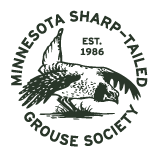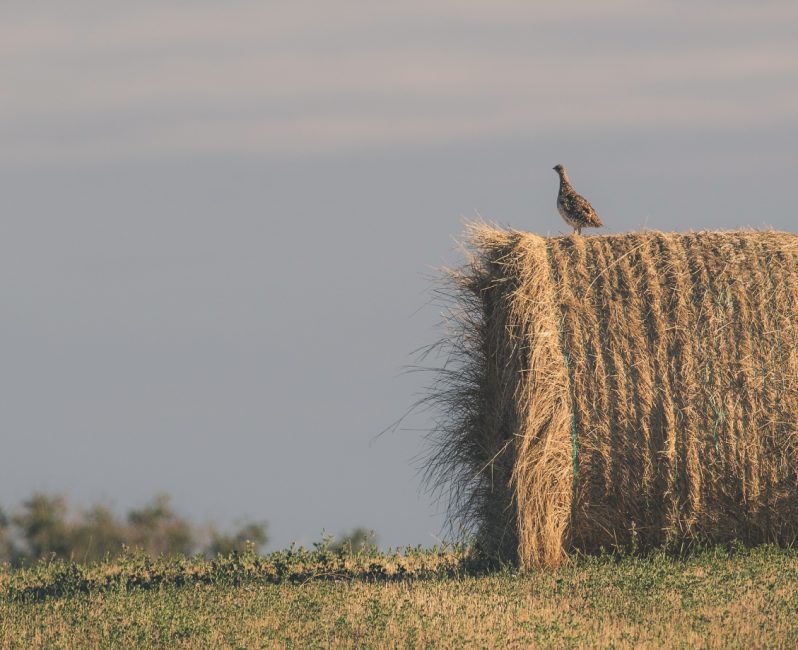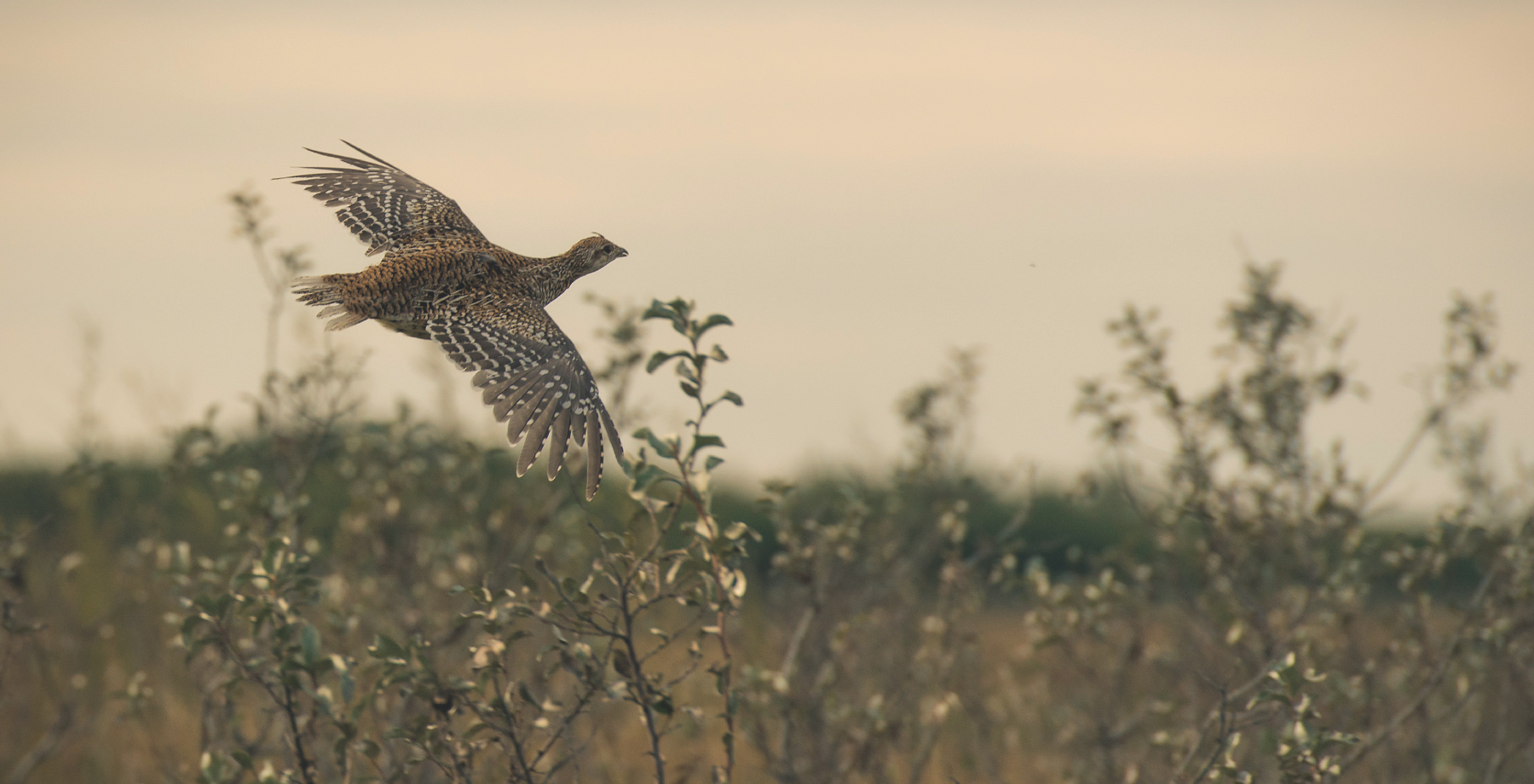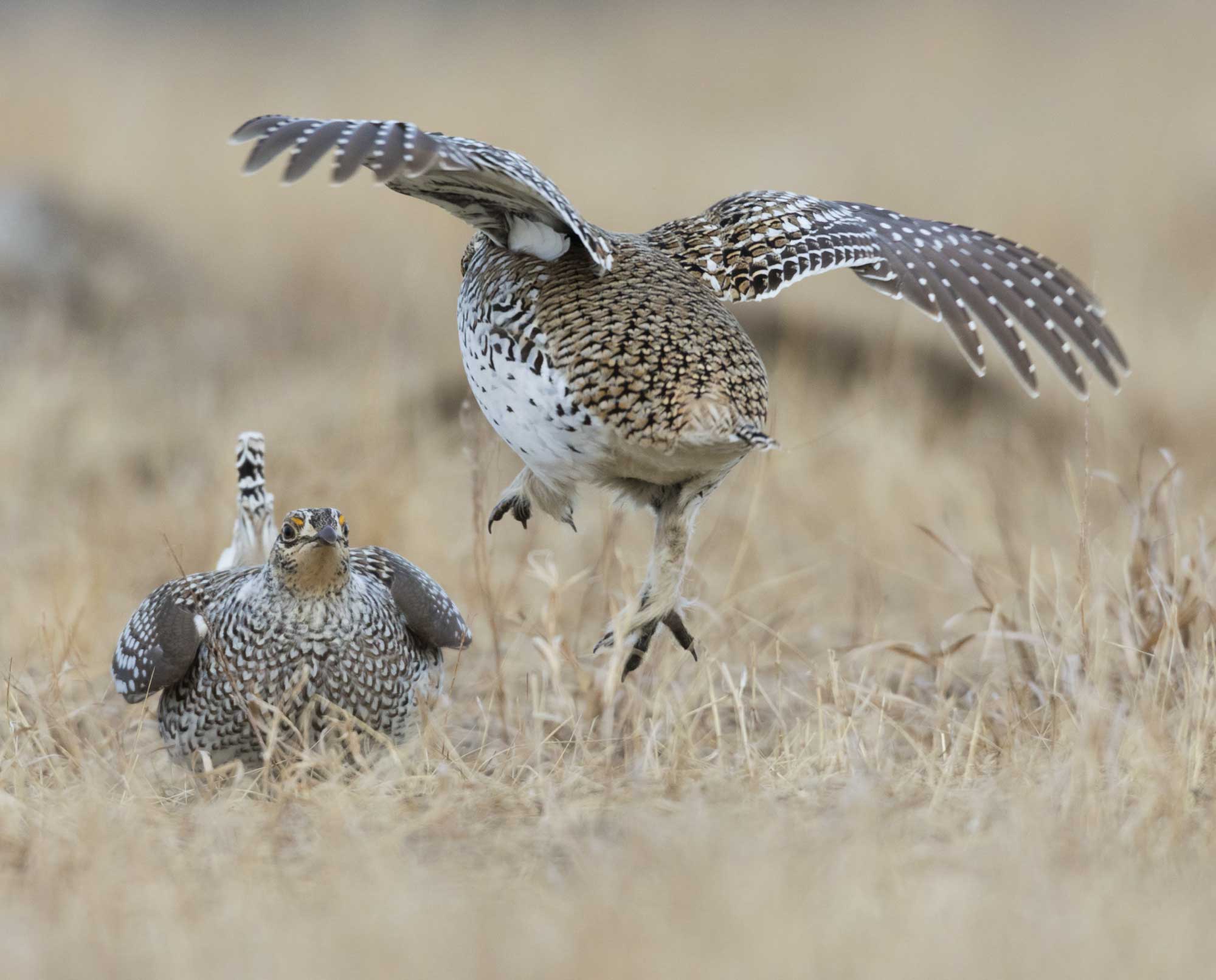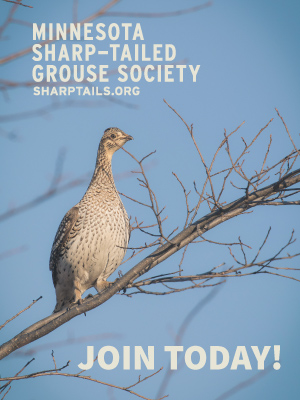The sharp-tailed grouse, Minnesota’s only “native” prairie grouse, goes by many names. It’s called “sharptail” because of its two long and pointed central tail feathers. It’s called “the in-between bird or brush chicken” because of its love for large areas of open brush, with some grass. And, Native North Americans called it the “fire bird” because of the sharptail’s affinity for burned areas.
The sharptail is one of four grouse species in Minnesota. The prairie chicken was not native to the state, but followed agricultural development from the southeast during the 1800’s, and needs grass landscapes. It is now present mainly on the glacial beach ridges of northwestern Minnesota. The sharptail was found statewide during pre-settlement times, and really flourished during the logging and homesteading era. The ruffed grouse, Minnesota’s most abundant upland game bird, is found wherever young to middle-aged forests occur, and the spruce grouse is found in older spruce and balsam forests in far northern Minnesota.
Through the 1900’s, the sharptail’s range decreased as agriculture became more intensive. They were still common in the 1940’s in southern Minnesota, and a remnant population survived in the Owatonna area into the 1960’s. But as homesteads were abandoned, and old fields were reclaimed by northern forests, and fire detection and suppression became more efficient, the fire bird’s range decreased. Today, sharptails are found mainly on the flat, formerly ditched brush landscapes of northwestern and east-central Minnesota. Although their numbers are down in Minnesota, they have fared much poorer to the east. They are gone from Illinois and Iowa. In Michigan, sharptails are restricted to a few areas in the Upper Peninsula, and in Wisconsin, only a few remnant populations survive.
As recently as 1949, hunters took 150,000 sharptails in Minnesota, and in the late 1970’s, harvests approximated 50,000. Back then, it was Minnesota’s third ranked game bird, behind ruffed grouse and pheasants. In response to declining populations from habitat loss, sharptail harvests have gradually declined further to about 10,000 annually. Sharptails slightly follow the 10-year population cycle of ruffed grouse. Presently, woodcock and even spruce grouse hunter harvests surpass those of sharptails.
Sharptails inhabiting the western Great Lakes States and provinces (including most of Manitoba) require large landscapes dominated by brush and grass. Although some agriculture such as small grain farming is beneficial, it is not necessary. The minimum size open area that will sustain a sharptail population is roughly two square miles. Although some trees such as aspen and birch are tolerated, conifers are not. That’s because the sharptail evolved over eons as an open lands bird. Sharptail habitat in Minnesota is any large open and relatively treeless complex of brush and grass, such as old fields, muskeg, bogs, and agricultural land. It even includes some abandoned mineland, and airports. The key to managing sharptail habitat is maintaining large areas in grass and brush. This is accomplished by prescribed burning and logging of large clearcuts, and by controlling overmature brush by shearing, mowing, hydroaxing, hand cutting, and sometimes, rotational grazing and herbicides. The cost ranges from $4 per acre for large burns to $90 per acre of mowing. Much of the work is on sites that have long-term fire histories, and which have likely held sharptails for centuries.
The sharptail is known not only as a challenging upland game bird, but also, for its spring courtship display, known as “dancing.” During spring mornings, groups of two to thirty males gather on traditional dancing grounds to woo a mate. With wings spread, tail erect, and head down, each male competes with the others on its own tiny piece of ground by rattling its central tail feathers, stomping its feet, cooing, and inflating its purple air sacks and yellow eye brows. Morning after morning, the same ritual continues until the hens are bred. Viewing dancing sharptails from observation blinds is a spectacular birding activity and photo opportunity, and each spring, hundreds of persons take part.
Mail carrier population surveys and hunter bagchecks documented the sharptail decline through the 1950s, and as a result, in 1964 DNR (then, the Department of Conservation) initiated three long-term sharp-tailed grouse research projects, all in northwestern Minnesota. One evaluated the effects of hunting and land use on sharptail populations, another investigated spring nesting and brood habitat, and a third converted mature aspen forest to brushland with the use of prescribed fire. Certain aspects of those projects continued until 1979. But prospects for saving the sharptail population seemed bleak, and I recall a 1971 prediction by the late Bob Farmes, DNR Area Wildlife Manager at Thief River Falls, that “if habitat loss continues, the sharptail will cease to become a hunted species by Year 2000.” It so happens that in 1971, I was hired by DNR as a wildlife biologist, and one of my jobs was to assume responsibility for completing the older sharptail projects, and try to apply their findings. One of the first jobs was to establish an annual sharptail population survey; this commenced in the northwest and east-central ranges in 1976 and continues to the present.
But sharptail numbers continued downward. There was little management, and forces such as maturing brushlands, forests replacing brushlands, planting of conifer plantations in sharptail habitat, intensive agriculture and land clearing, little prescribed fire and better wildfire suppression, all seemed insurmountable. DNR was close to writing off the sharptail in Minnesota—essentially the same as Michigan and Wisconsin had already done. A native Minnesota bird was about to be lost.
Beginning in the mid-1980s, a number of factors brought some hope that the sharptail might be saved. The somewhat controversial concept of “ecosystem management” identified brush landscapes as an ecosystem that should be managed not only for sharptails, but also for deer, moose, and furbearers, and a host of unique nongame birds such as the sandhill crane, short-eared owl, yellow rail, bobolink, and sharp-tailed sparrow. Thus, the term “brushland management” was coined. As the research findings of the old habitat and populations studies were applied, there was now a scientific basis for more prescribed burning, and more funds for burning and burn training were allocated. In 1986, a small group of Minnesota sportsmen founded the Minnesota Sharp-tailed Grouse Society, which eventually influenced future management decisions by DNR (more on this later). Around 1990, the DNR Division of Fish and Wildlife began a Long Range Planning process, and sharptails and brushlands were among the species and habitats covered. The sharptail Long Range Plan stated that DNR’s goal was to maintain a population that would sustain a harvest of 50,000 birds annually. Since the mid-1990s there have been specific funding allocations for prescribed burning, brushlands management, and work on private lands. In 2001, DNR hired regional Private Lands Wildlife Specialists, and in 2002, funds were made available under the legislature’s Heritage Enhancement Program for conservation organizations to do habitat work on Wildlife Management Areas.
Thus, the table was finally set for a full menu of brushlands management in Minnesota, with the emphasis on sharptails, but under which dozens of species would be helped. “Brushlands management” is a relatively new activity for DNR, and is progressing on certain WMA’s and other state, county, and private lands. On managed sites, sharptail numbers are responding nicely. But sharptails and other native bird species are still gradually declining on other open lands. Challenges remain, including additional funding for management, and controlling the planting of hybrid poplar and conifer plantations in open lands.
The Minnesota Sharp-tailed Grouse Society (MSGS) was founded in 1986 by Roche Lally of Duluth. MSGS is “dedicated to the management and restoration of sharptails in Minnesota for hunters and non-hunters” and works hard towards that goal. With around 300 members, it has provided funding to DNR for prescribed burning equipment, printing of informational brochures, land acquisition, and habitat management. MSGS builds and maintains observation blinds, publishes a quarterly newsletter, and sponsors an annual habitat management project. In the last three years, MSGS has received $236,120 in state Heritage Enhancement Grant for contracted habitat work on WMAs. MSGS’s success hatched three other groups, The Wisconsin Sharp-tailed Grouse Society, The Michigan Sharp-tailed Grouse Association, and Sharptails Plus of Manitoba. After 18 years at the helm of MSGS, Lally is still enthusiastic about sharptails, and has watched his old hunting grounds in St. Louis County again have huntable sharptails. To learn more about MSGS, click on www.mnsharptails.org or write PO Box 3338, Duluth MN 55803.
What is the future of sharptails in Minnesota? It depends on continued brushlands management funding, and cooperation between a number of partners, including DNR’s Division of Forestry, The Nature Conservancy (which now manages large land holdings in northwestern Minnesota), federal Natural Resources Conservation Service, birding enthusiasts, and private landowners. New on the horizon is natural brushland biomass harvesting, which has the potential for managing large expanses of brushlands for biofuels at almost no cost to DNR.
Sharptail numbers can never return to those of the homestead era. But it is possible to manage habitat towards DNR’s goal of a 50,000 yearly sharptail harvest. Gradually, hunters accustomed to traveling to the Dakotas are re-discovering sharptails in Minnesota, and northern communities are again benefiting from the expenditures of sharptail hunters in the fall. Gradually, birdwatchers are discovering the thrill of watching a short-eared owl or sandhill crane, or of watching sharptails dance in the spring. Gradually, sharptails are coming back.
Last modified: February 2, 2019
